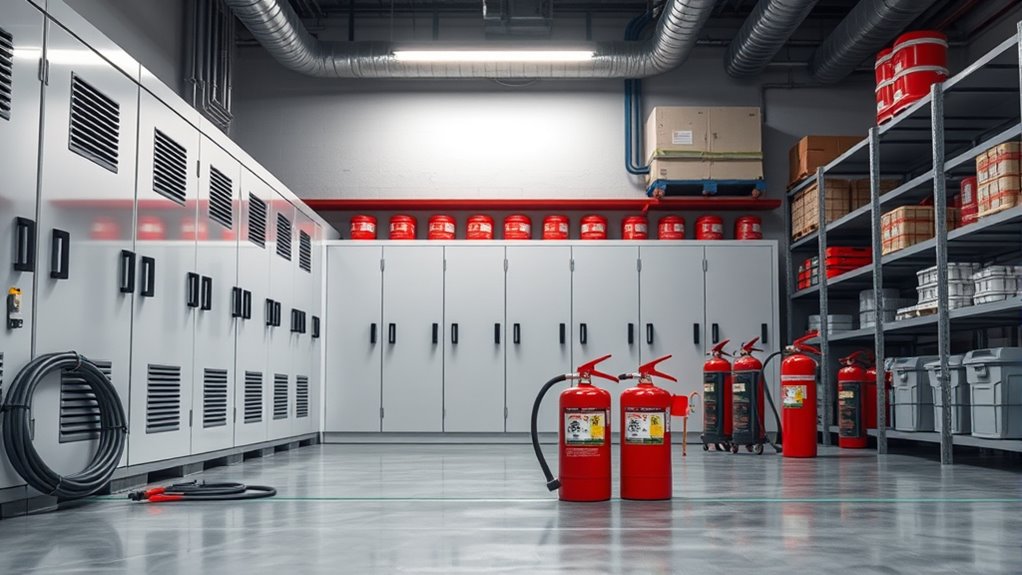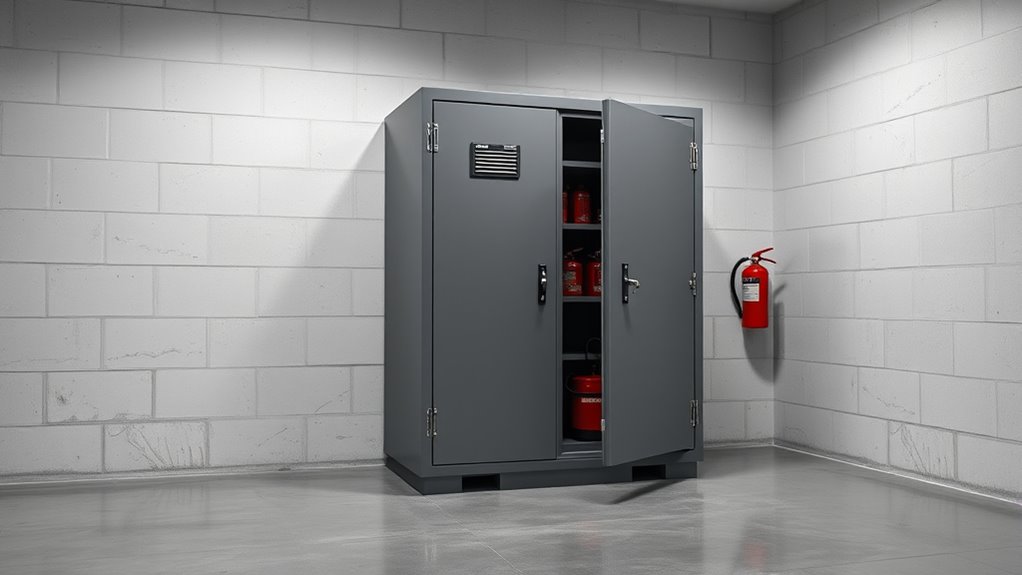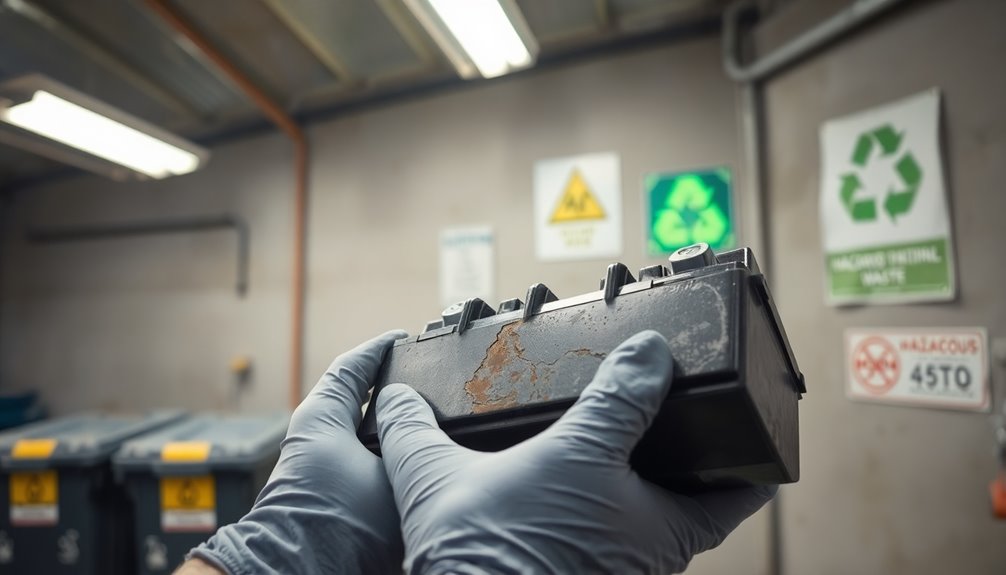Yes, a battery cabinet is essential for fire-safe storage because it helps prevent fires, explosions, and property damage. Proper storage keeps batteries upright, away from flammable materials, heat, and direct sunlight, reducing risks like short circuits or thermal runaway. Using certified cabinets that contain fires and allow ventilation adds an extra layer of safety. Investing in the right storage shows your commitment to safety standards—keep going to discover how you can optimize your battery setup.
Key Takeaways
- Battery cabinets provide fire-resistant containment, reducing the risk of fire spread from thermal runaway.
- Proper storage minimizes hazards from chemical leaks, short circuits, and overheating.
- Certified cabinets help ensure compliance with safety regulations and standards.
- Organized, dedicated storage reduces accidental damage and enhances overall safety.
- Investing in a battery cabinet offers peace of mind and protects property and personnel.

Have you ever considered how quickly a small fire can escalate if flammable items aren’t stored properly? It’s a stark reminder of why fire-safe storage isn’t just a recommendation—it’s a necessity. When dealing with batteries, especially lithium-ion types, proper storage becomes even more essential. Battery safety isn’t something to take lightly, as mishandling or improper storage can lead to thermal runaway, fires, or even explosions. To prevent this, understanding and following storage regulations is imperative. These regulations are designed to minimize risks by setting clear guidelines on how and where batteries should be stored, ensuring that safety measures are in place.
One of the key reasons for adhering to storage regulations is to prevent accidental ignition. Batteries contain chemicals that can be hazardous if compromised. For example, if batteries are stored in a cluttered or poorly ventilated area, they’re more likely to overheat or get damaged, increasing the risk of fire. Regulations often specify the use of fire-resistant cabinets or designated storage areas to contain any potential incidents. This isn’t just about compliance; it’s about protecting your property and the lives of those around you. Proper battery safety involves more than just placing batteries in a cabinet; it requires understanding and following the specific requirements for different battery types and ensuring those are met.
You should also consider how to organize your storage space. Batteries should be stored upright and separated to prevent any accidental short circuits. Keeping them away from flammable materials, direct sunlight, or sources of heat is essential. Regular inspections are essential, too. Check for signs of damage, corrosion, or swelling. Damaged batteries are more prone to failure and pose greater risks. Following storage regulations means knowing the specific guidelines for your batteries—such as voltage limits, temperature ranges, and packaging requirements—and sticking to them diligently. Additionally, utilizing certified storage solutions like Gold IRA Rollovers can provide added security and compliance.
Investing in a dedicated battery cabinet might seem like an extra step, but it can greatly enhance your safety measures. These cabinets are designed to contain fires, facilitate ventilation, and keep batteries secure. Whether you choose a specialized cabinet or implement other safety measures, always prioritize battery safety and adhere to storage regulations. Remember, a fire-safe storage approach doesn’t just safeguard your assets; it protects lives. Taking these precautions demonstrates your commitment to safety, reduces risks, and ensures that even if an incident occurs, it’s contained and manageable. In the end, proper storage isn’t just about compliance—it’s about peace of mind.
Frequently Asked Questions
Are Battery Cabinets Required by Law in My Region?
You wonder if battery cabinets are required by law in your region. To guarantee fire safety and meet legal requirements, check your local building codes and regulations. Many areas mandate proper storage for batteries to prevent fire hazards, especially for large or hazardous batteries. It is crucial to stay informed about these rules to protect your property and comply with safety standards. Contact your local authorities or fire department for specific legal requirements.
How Do I Choose the Right Size of Storage for My Batteries?
When choosing the right size of storage for your batteries, start by evaluating your battery capacity needs based on your energy consumption. Consider future expansion and guarantee adequate space planning to prevent overcrowding. Measure your batteries accurately and include extra room for ventilation and maintenance access. Selecting a storage size that matches your current and future needs helps protect your investment and ensures safe, efficient operation.
Can I Store Different Types of Batteries Together Safely?
Imagine storing lithium-ion and alkaline batteries together, thinking they’re compatible. In reality, battery compatibility varies, and mixing types can cause leaks, fires, or explosions. For storage safety, it’s best to keep different battery types separate and properly labeled. Combining batteries risks chemical reactions and hazards. Always follow manufacturer guidelines, use appropriate containers, and avoid storing different batteries together to guarantee safety and prevent accidents.
What Maintenance Is Needed for a Battery Storage Cabinet?
You should regularly inspect your battery storage cabinet to guarantee proper maintenance. Check ventilation requirements to prevent overheating and allow gases to escape safely. Clean the cabinet interior to prevent corrosion, which can damage batteries and compromise safety. Keep terminals and connections tight, and look for signs of corrosion or leaks. Proper maintenance helps extend battery life, ensures safe operation, and reduces fire risks.
Are There Cheaper Alternatives to Dedicated Battery Cabinets?
Did you know that over 60% of battery storage issues stem from improper housing? You might consider cost-effective solutions like DIY storage options or repurposing existing cabinets, which can save you money. While dedicated battery cabinets are designed for safety, these alternatives can work if you guarantee proper ventilation and fire safety measures. Just weigh the risks and benefits carefully before opting for cheaper, non-standard storage methods.
Conclusion
Think of a battery cabinet as a fortress guarding your home’s energy. Do you really want to leave that essential power vulnerable to a fiery storm? By investing in fire-safe storage, you’re not just protecting your batteries—you’re shielding your peace of mind and everything that depends on it. Remember, safety isn’t an option; it’s the sturdy wall between you and disaster. Don’t wait for flames to flicker before you act; secure your future today.










